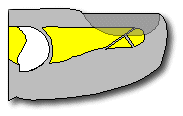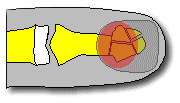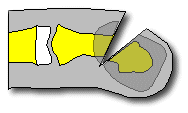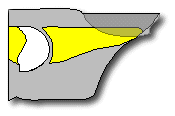| What is it? |
-
This section deals with acute or recent injuries, ranging
from a bruise or scrape to having the end of the finger taken off.
Treatment of healed or nearly healed fingertip injuries is a different
situation.
-
When portions of the fingertip are missing, the injury is usually
described as a partial amputation.
-
When the finger is cut more than halfway through, the injury may
be described as a subtotal amputation.
-
Here are some of the more common types of fingertip injuries and what they
are called by doctors:
 |
Distal phalanx tuft fracture. |
 |
Comminuted distal phalanx tuft fracture with subungual hematoma (blood
under the fingernail). |
 |
Subtotal amputation with open fracture and nail bed injury. |
 |
Palmar oblique fingertip amputation with pulp loss. |
|
| What caused it? |
-
Usually a cut or crush, caught in a door, window, gear, belt, saw,
etc.
|
| What can you do to help? |
-
Ice, elevation, and have it checked out by a doctor. If the injury involved
a cut, medical evaluation is particularly important - to check whether
or not a tetanus shot, antibiotics or other treatment is required, even
if stitches aren't needed.
|
| What can a therapist do to help? |
-
A hand therapist can be very helpful in providing a protective splint,
guiding special exercises to improve movement and strength, and making
the hand feel better in general.
-
However, the most common and difficult problem that people have after a
fingertip injury is tenderness or hypersensitivity of the tip. This
can be quite disabling. Desensitization exercises, supervised by a hand
therapist, are the key to correcting this problem - which otherwise may
not go away on its own.
|
| What can a doctor do to help? |
-
The exact treatment really depends on the exact type of injury. Injuries
may involve skin, bone, fingernail, or any combination, and treatment requires
separate consideration of each:
| Injury of... |
Problem |
Treatment might involve... |
| Skin |
Cut |
-
Let it heal on its own
-
Put in stitches
|
| Partly missing |
-
Let it heal on its own
-
Skin graft (skin moved from
original location)
-
Skin flap (skin partly connected
to original location)
-
Trim the bone back
|
| Nail |
Blood under the fingernail |
-
Leave it alone
-
Drain the blood through a hole
in the fingernail
-
Remove the fingernail and put
in stitches
|
| Cut |
-
Let it heal on its own
-
Put in stitches
|
| Partly missing |
-
Let it heal on its own
-
Graft
-
Remove the remaining nail bed:
no more nail
|
| Bone |
Broken |
-
Splint or cast
-
Temporary metal pin
|
| Partly missing |
-
Shorten the finger
-
Bone graft
|
|
| How successful is treatment? |
-
The ordeal of recovery as well as the final result depends as much on the
person as on the actual injury - two people with basically the same injury
can have great differences in pain, stiffness, recovery time and final
outcome. Early proper medical care is the best first step towards the best
possible outcome.
-
In rare occasions, a completely amputated fingertip may just be sewn back
on, either repairing the blood vessels (microsurgical replantation) or
not (composite grafting). Unfortunately, this is usually not nearly as
successful as might be expected, particularly in adults or when the tip
has been crushed in a door. Even with microsurgery, only a disappointingly
small percent of fingertip amputations are successfully replanted.
Fortunately, there are many options other than replantation that hand surgeons
can offer provide a satisfactory result.
|
| What happens if you have no treatment? |
-
It's a roll of the dice. You may luck out and wind up with a pretty good
result. However, if the injury really needs surgery, it's best to do it
right away.
|
|